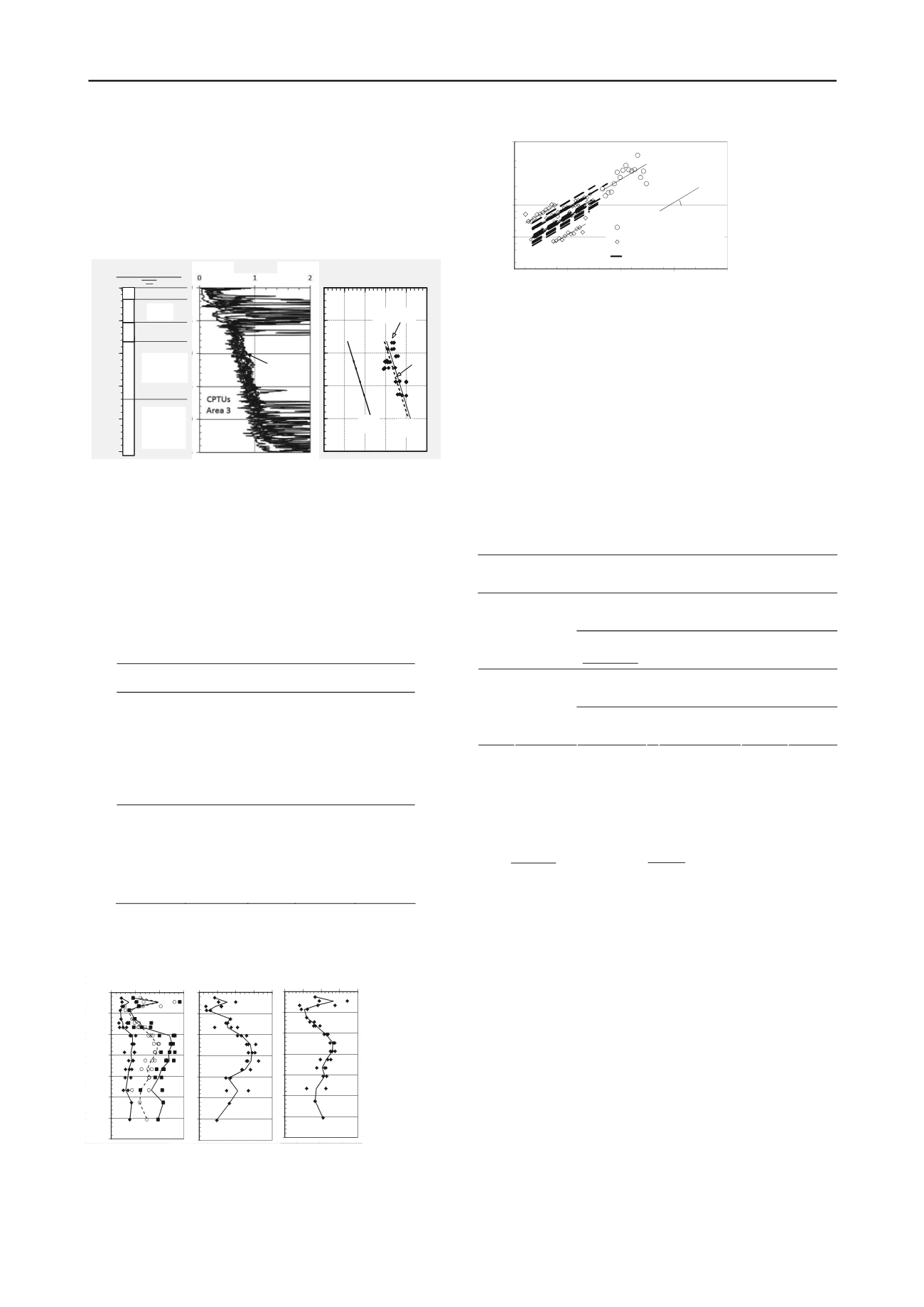
2962
Proceedings of the 18
th
International Conference on Soil Mechanics and Geotechnical Engineering, Paris 2013
and residual soils from gneiss. Figure 2 illustrates the local
subsoil, without the Transitional Clay and the residual soils.
Eolic deposits were always present in the area, including Santo
Amaro Island and Santos City Plain. Their weights were
responsible for the higher values of SPT, ranging from 2 to 4 as
well as the overconsolidation of the deposits.
0 50 100 150 200 250
Pressures (kPa)
0
5
10
15
20
25
0
5
10
15
20
25
z - Depth (m)
WT
Soft Clay
(SFL)
'
vo
'
p
Odometer
Sand
Mangrove
Clayey Sand
115+4.9z CPTU
Clay and
Sand
(SFL)
0
500 1000 1500
qt (kPa)
0
5
10
15
20
25
q
t
=b.
z
(a)
(b)
q
t
(M )
Figure 2. Odometer tests vs. 7 CPTUs at Area 3 of Figure 1.
The main properties of the marine clays are presented in Table
1, separated in two parts: the upper one emphasizes the
differences and the lower one stresses the similarities. As it can
be seen, their index properties are almost the same and they
differ in their “state properties”, like undrained shear strength,
void ratio and SPT. It is interesting to mention that negative
B
q
values were observed for the Pleistocene Clays, whose
preconsolidation, with high OCR, was confirmed by
consolidation tests on undisturbed samples (Massad 2009-a).
Table 1.Properties of the Marine Holocene and Pleistocene Clays
Group
Item
Man-
grove
SFL
AT
Depth(m)
5
50
20-45
SPT
0
0-4
5-25
B
q
-
0.4-0.9
-0.1-0.2
Differences q
t
(MPa)
-
0.5-1.5
1.5-2.0
e
>4
2-4
<2
’
p
(kPa)
<30
30-200
200-700
OCR
1
1.1-2.5
>2.5
s
u
(kPa)
3
10-60
>100
n
(kN/m
3
) 13.0
13.5-16.3 15.0-16.3
%<5
-
20-90
20-70
w
L
40-150
40-150
40-150
Similarities I
P
30-90
20-90
40-90
C
c
/(1+e
o
)
0.36
0.43
0.39
Cr/Cc(%)
12
8-12
9
R
f
(%)
-
1.5-4.0
1.5-2.0
Legend: SI Symbols used
Data from 3 borings in Area 3 are presented in Figure 3.
0
5
10
15
20
25
30
35
0 1 2 3 4
z - Depth (m)
Void ratio
0
5
10
15
20
25
30
35
0 20 40 60 80
z - Depth (m)
Clay Content (%)
0
5
10
15
20
25
30
35
0 50 100 150
z - Depth (m)
Water Content (%)
w
p
w w
l
Figure 3. Data from 3 borings (SS110; SS115;SS120) in Area 3.
0
100
200
300
400
0
100
200
300
400
´
p
(kPa)
s´vo (kPa)
Santos City
SLF - Sto. Amaro Island
SFL - EMBRAPORT
45
o
Figure 4.
’
p
from CPTUs as a function of the
’
vo
.
About 20 stress history profiles, from odometer tests and
CPTUs, carried out in sites of the Santos Plain, like Figure 2,
showed that equation (1) holds;
C
1
and
C
2
are constants.
1
vo
p
C '
'
or
z'.
C '
2
p
(1)
Figure 4 illustrates its validity and Table 2 shows values of
C
1
for the 4 Classes of SFL Clays (Massad 2009-a). These findings
have a practical consequence: more than 12 experimental earth
fills settled in a wide range of values
(
EOP
=1 to 12%) and of
velocities (
c
v
c
h
~3.10
-3
to 5.10
-2
cm
2
/s), depending on
OCR
.
Note that for the SFL clays c
v
c
h
(Massad 2009-a).
Table 2.Classes of Holocene Clays (SFL). Santos Coastal Plain
Class
Clay
Profile
Site
Consolidation
Mechanism
OCR
’
p
-
’
vo
(c
o
)kPa
1
Baixada
Santista
Neg. Sea
level Osc.
1.3-2.0
20-30
(5-20)
2
Out-
cropping St.Amaro I
Embraport.
Dune
Action
>2.0
50-120
(25-45)
3
Santos
City
Neg. Sea
level Osc
1.0-1.3
15-30
(10-30)
4
Beneath
8-12m of
sand layer
Santos
City
Dune
Action
>1.4
40-80
(>35)
Legend: SI Symbols used; stresses and c
o
(of Eq. 3) in kPa;
For the SFL clays of Santos Coastal Plain there is a linear
increase of
q
t
with depth, with a rate b. Massad (2009-b) used
this fact and equation (1) to estimate the empirical factor
N
t
of
Kulhaway and Mayne (1990), as shown in Equation 2.
t
vo
t
p
N
q
´
with
´
n
t
b
N
(2)
The use of equation 2 with
b
=34MPa/m for the SFL clay layer
of Embraport site (see Figure 2-a) resulted in
N
t
=3.9 and the
constant
C
2
of equation 1 varying from 80 to 115kPa, revealing
the great heterogeneity of the soil (see also Teixeira 1960 on
this feature). The high values of
’
p
for the Embraport site are
associated with
OCR
>2 at mid height of the layer, as shown in
Table 2. Furthermore, Figure 2-b shows also data of odometer
tests (dashed line is the average) carried out by Andrade (2009)
that agree with the
´
p
of the nearest CPTU.
The shear strength of the SFL clays follows the equation
s
u
=c
o
+c
1
.z
, with
c
1
=0.4
´.For Embraport site the
c
o
values are
higher (Table 2), as those found in Santos City (Teixeira 1994).
Figure 5 shows that: a) the
c
h
for the overconsolidated range
(o.c.) varies from 4.7x10
-3
to 1.5x10
-1
cm
2
/s (mean value of
2.1x10
-2
cm
2
/s) for the soft clay (SFL) layer (8 to 17m depth);
and b) the upper sand and the lower clay/sand layers are highly
permeable. In cases like this there is no need to use drains, as
shown by Pilot (1991) besides local practice (Massad, 2009-a).


